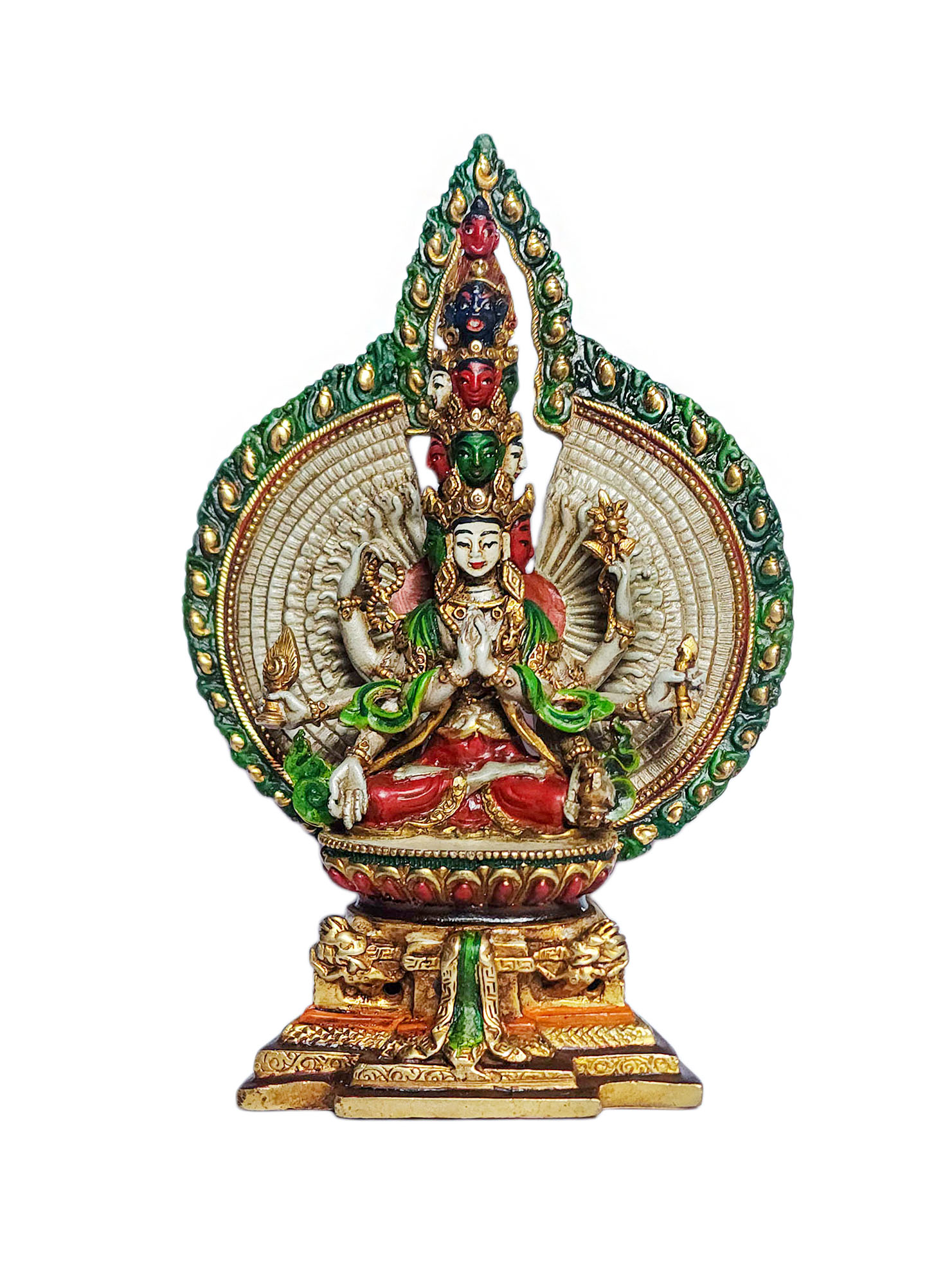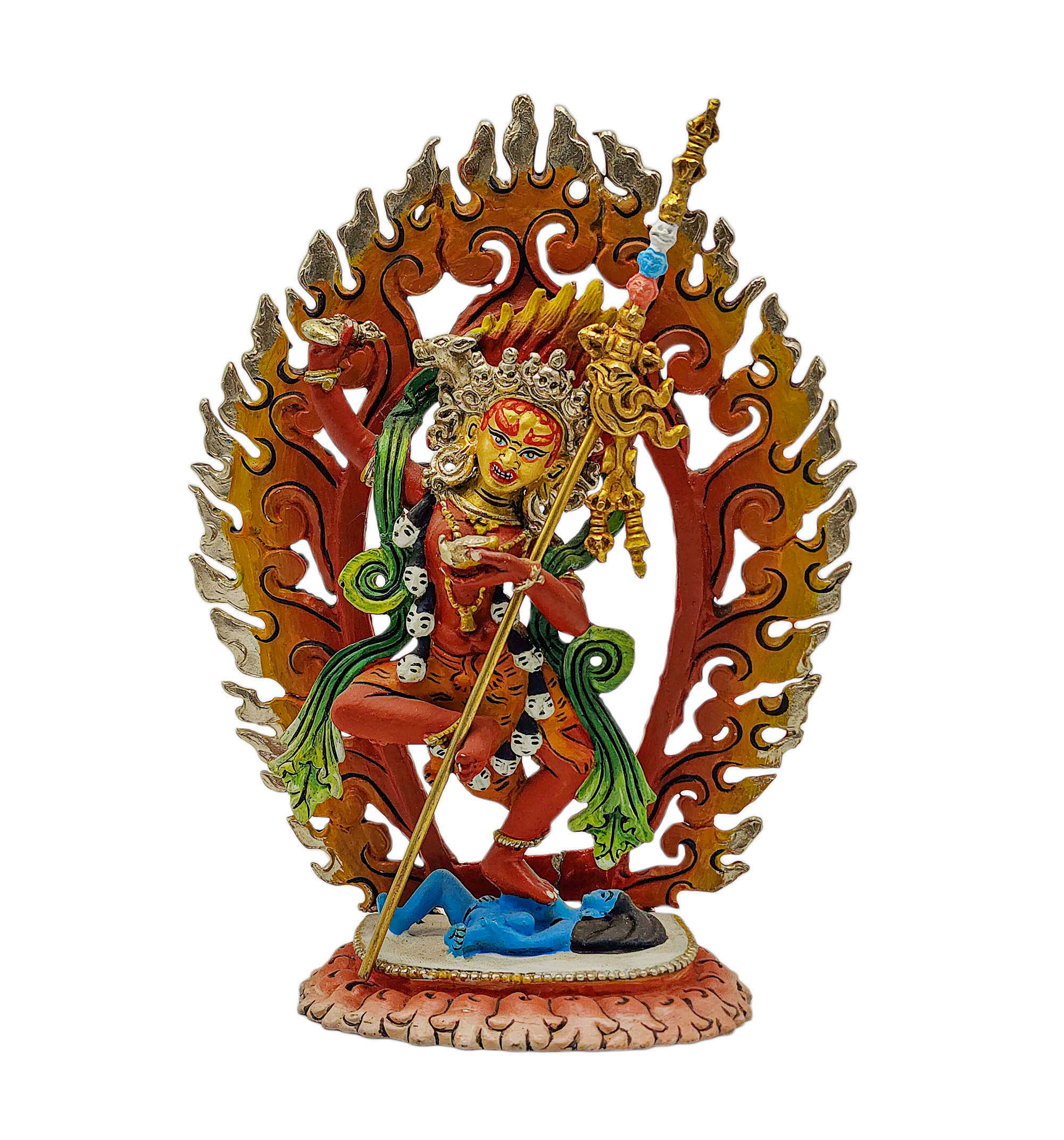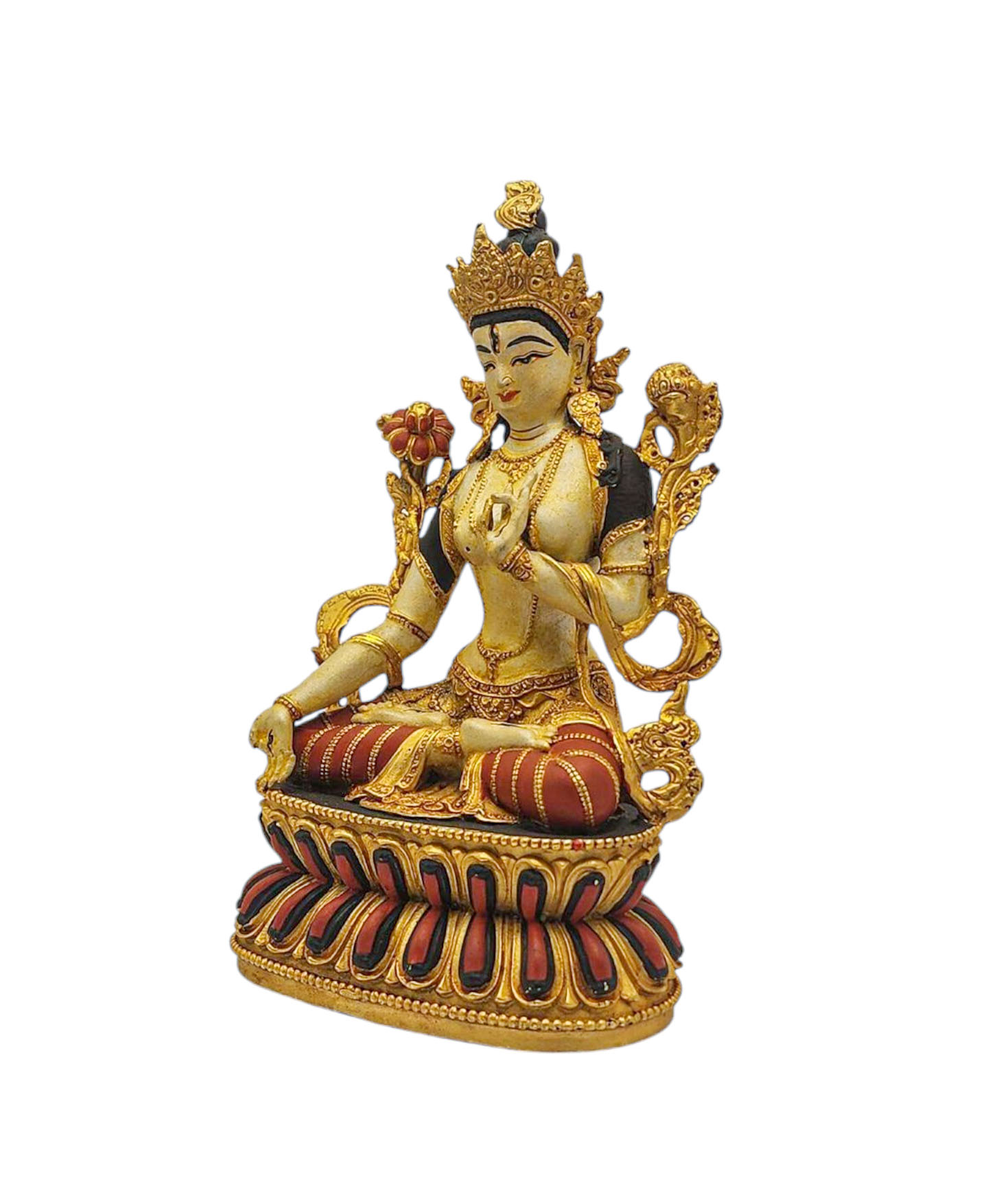Code
HCS35180
Weight
285 gm / 0.63 lbs
Size
Height
13cm (5") Width
9cm (4") Depth
5cm (2") Material
Copper
Availability
Available

Safe Payment
We accept Paypal, Money Transfer, Bank Transfer
Confidence
Protection covers your purchase and personal data.
Worldwide Delivery
We ship Worldwide, except Russia.Shipping cost US$25.2 for upto 0.5 kgs

Hotline
Talk to help line for your question on 9841267335Chenrezig : Brief Introduction
Of all the deities in Mahayana Buddhism, the bodhisattva Avalokiteshvara, Chenrezig, is one of the most celebrated. He is the lord gifted with complete enlightenment, who refrains from entering the blissful state of nirvana to remain here below and save the living being of the earth. This devotion to the salvation of others emphasizes profound compassion.
Compassion for others had always been regarded as a virtue in early Buddhism, but it had a somewhat subordinate place to wisdom. In Mahayana Buddhism, compassion received an equal emphasis with wisdom, perhaps because the Mahayana was more consciously universal and covered a wider sector of society. In this view of the world, all men and women, not just those leading a monastic life, could achieve nirvana. Read More . . .
Of all the deities in Mahayana Buddhism, the bodhisattva Avalokiteshvara, Chenrezig, is one of the most celebrated. He is the lord gifted with complete enlightenment, who refrains from entering the blissful state of nirvana to remain here below and save the living being of the earth. This devotion to the salvation of others emphasizes profound compassion.
Compassion for others had always been regarded as a virtue in early Buddhism, but it had a somewhat subordinate place to wisdom. In Mahayana Buddhism, compassion received an equal emphasis with wisdom, perhaps because the Mahayana was more consciously universal and covered a wider sector of society. In this view of the world, all men and women, not just those leading a monastic life, could achieve nirvana. Read More . . .
About Color Finishing
The [sahasrabhuja Avalokitesvara], Buddhist Miniature Statue, [thangka Color Finishing] is adorned with traditional colors, creating a captivating aesthetic through a combination of gold and various hues. This painting technique follows a time-honored process that aims to faithfully represent the [sahasrabhuja Avalokitesvara], Buddhist Miniature Statue, [thangka Color Finishing] in accordance with traditional color descriptions. In the context of Buddhist statues, this approach holds great significance. Each statue has its own primary color, and it is crucial to depict the statue in its authentic shade. Read More . . .
The [sahasrabhuja Avalokitesvara], Buddhist Miniature Statue, [thangka Color Finishing] is adorned with traditional colors, creating a captivating aesthetic through a combination of gold and various hues. This painting technique follows a time-honored process that aims to faithfully represent the [sahasrabhuja Avalokitesvara], Buddhist Miniature Statue, [thangka Color Finishing] in accordance with traditional color descriptions. In the context of Buddhist statues, this approach holds great significance. Each statue has its own primary color, and it is crucial to depict the statue in its authentic shade. Read More . . .
Ceramic Molding System
The [sahasrabhuja Avalokitesvara], Buddhist Miniature Statue, [thangka Color Finishing] has been crafted using the Ceramic mold casting process, a modern approach that provides an alternative to traditional methods such as the lost-wax system or rubber molding. Also referred to as ceramic molding, this technique involves the creation of a ceramic mold to cast the statue. The process begins by making a precise and detailed wax model of the desired sculpture. The wax model is then coated with layers of ceramic material, creating a sturdy mold. Once the mold is complete, it is fired in a kiln, causing the wax to melt and escape, leaving behind a cavity that perfectly replicates the original sculpture. Molten metal is then poured into the mold, allowing it to fill the cavity and take on the desired form. Once cooled and solidified, the ceramic mold is carefully broken away, revealing the final metal statue. Read More . . .
The [sahasrabhuja Avalokitesvara], Buddhist Miniature Statue, [thangka Color Finishing] has been crafted using the Ceramic mold casting process, a modern approach that provides an alternative to traditional methods such as the lost-wax system or rubber molding. Also referred to as ceramic molding, this technique involves the creation of a ceramic mold to cast the statue. The process begins by making a precise and detailed wax model of the desired sculpture. The wax model is then coated with layers of ceramic material, creating a sturdy mold. Once the mold is complete, it is fired in a kiln, causing the wax to melt and escape, leaving behind a cavity that perfectly replicates the original sculpture. Molten metal is then poured into the mold, allowing it to fill the cavity and take on the desired form. Once cooled and solidified, the ceramic mold is carefully broken away, revealing the final metal statue. Read More . . .


![[sahasrabhuja Avalokitesvara], Buddhist Miniature Statue, [thangka Color Finishing]](https://handmadeexpo.com/pics/product/thumb/35180.jpg)
![[sahasrabhuja Avalokitesvara], Buddhist Miniature Statue, [thangka Color Finishing]](https://www.handmadeexpo.com/pics/product/thumb/35180_0.jpg)
![[sahasrabhuja Avalokitesvara], Buddhist Miniature Statue, [thangka Color Finishing]](https://www.handmadeexpo.com/pics/product/thumb/35180_1.jpg)
![[sahasrabhuja Avalokitesvara], Buddhist Miniature Statue, [thangka Color Finishing]](https://www.handmadeexpo.com/pics/product/thumb/35180_2.jpg)
![[sahasrabhuja Avalokitesvara], Buddhist Miniature Statue, [thangka Color Finishing]](https://www.handmadeexpo.com/pics/product/thumb/35180_3.jpg)

 Vajravarahi, Buddhist Miniature Statue,
Vajravarahi, Buddhist Miniature Statue,  Vajravarahi, Buddhist Miniature Statue,
Vajravarahi, Buddhist Miniature Statue,  Vajrayogini, Buddhist Miniature Statue,
Vajrayogini, Buddhist Miniature Statue,  Vajrayogini, Buddhist Miniature Statue,
Vajrayogini, Buddhist Miniature Statue,  Vajrasattva, Buddhist Miniature Statue,
Vajrasattva, Buddhist Miniature Statue,  Vajrasattva, Buddhist Miniature Statue,
Vajrasattva, Buddhist Miniature Statue, 
 with Double Base, Buddhist Miniature Statue
with Double Base, Buddhist Miniature Statue  with Double Base, Buddhist Miniature Statue
with Double Base, Buddhist Miniature Statue  White Jambhala, Buddhist Miniature Statue,
White Jambhala, Buddhist Miniature Statue,  White Jambhala, Buddhist Miniature Statue,
White Jambhala, Buddhist Miniature Statue,  Vajravarahi, Buddhist Miniature Statue,
Vajravarahi, Buddhist Miniature Statue,  Vajravarahi, Buddhist Miniature Statue,
Vajravarahi, Buddhist Miniature Statue,  Chenrezig, Buddhist Miniature Statue,
Chenrezig, Buddhist Miniature Statue,  Chenrezig, Buddhist Miniature Statue,
Chenrezig, Buddhist Miniature Statue,  White Tara,
White Tara,  White Tara,
White Tara,  of, Medicine Buddha,
of, Medicine Buddha,  of, Medicine Buddha,
of, Medicine Buddha,